About us
FASTPCBA Co.,Ltd
-
 Building 1, Senyang Electronic Technology Park, Guangming High-tech Park, Yutang Street, Guangming District, Shenzhen City.
Building 1, Senyang Electronic Technology Park, Guangming High-tech Park, Yutang Street, Guangming District, Shenzhen City.
-
 F:86-13418481618
F:86-13418481618
-
 [email protected]
[email protected]
 date:2020-11-21 14:50:33
date:2020-11-21 14:50:33
Surface Mount Technology (SMT) is developed from the traditional Through Hole Technology (THT), but it is different from the traditional THT.
From the perspective of assembly process technology, the fundamental difference between SMT and THT is "sticking" and "plugging." The difference between the two is also reflected in the substrate, components, component shape, solder joint shape and assembly process methods.
On the traditional THT printed circuit board, the components and solder joints are respectively located on both sides of the board; while on the SMT circuit board, the solder joints and components are on the same side of the board. Therefore, on SMT printed circuit boards, through holes are only used to connect wires on both sides of the circuit board, the number of holes is much smaller, and the diameter of the holes is much smaller. In this way, the assembly density of the circuit board can be greatly improved.

Surface Mount Technology (SMT)

Through Hole Technology (THT)
Compared with Through Hole Technology (THT), Surface Mount Technology (SMT) has the following advantages:
1. High assembly density, small size and light weight of electronic products. The volume and weight of SMD components are only about 1/10 of traditional plug-in components. Generally, after SMT is adopted, the volume of electronic products is reduced by 40% to 60%, and the weight is reduced by 60% to 80%.
2. High reliability and strong anti-vibration ability. Low solder joint defect rate.
3. Good high frequency characteristics. Reduce electromagnetic and radio frequency interference.
4. It is easy to realize automation and improve production efficiency.
5. Reduce costs by 30%~50%. Save materials, energy, equipment, manpower, time, etc.
Although the importance and superiority of SMT in electronic assembly technology are obvious, for many electronic products, the assembly technology is still inseparable from THT.
For example, we can often see large LED screens in squares, store entrances and train stations. The first consideration for outdoor LED screens is waterproof, because of the weather, whether it is raining or snowing. Once water enters the inside of the screen, it will cause a short circuit, which can burn the product at the slightest level and cause a fire. With SMT technology, it is more difficult for the screen to be waterproof, and the cost will increase exponentially, so it is rare to see screens using SMT chip processing technology. But it is easy to do this for products using THT process, and the cost will not be much higher. Just look at this industry from the large LED screen display. At least in the next 50 years THT will not be replaced by SMT.
 Building 1, Senyang Electronic Technology Park, Guangming High-tech Park, Yutang Street, Guangming District, Shenzhen City.
Building 1, Senyang Electronic Technology Park, Guangming High-tech Park, Yutang Street, Guangming District, Shenzhen City.
 F:86-13418481618
F:86-13418481618
 [email protected]
[email protected]